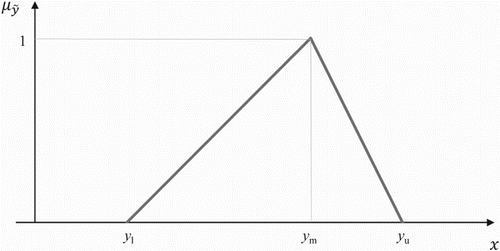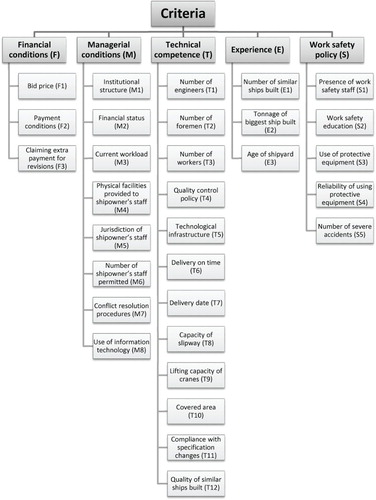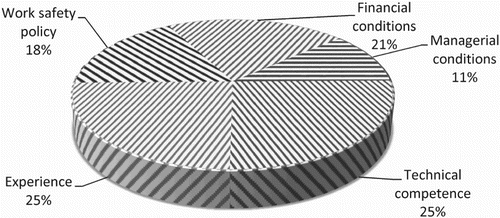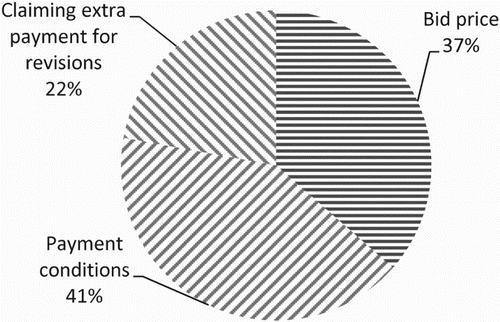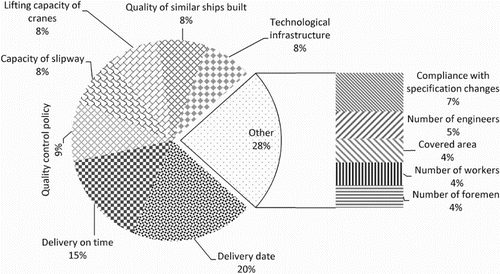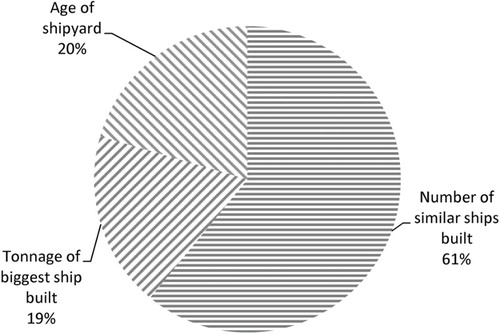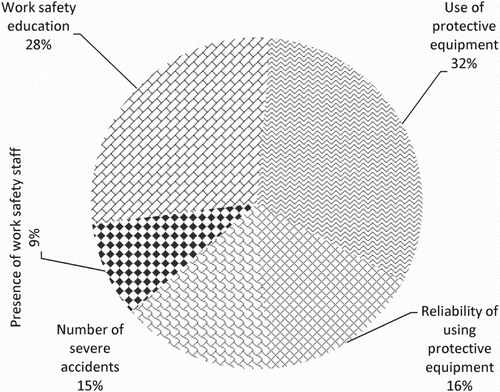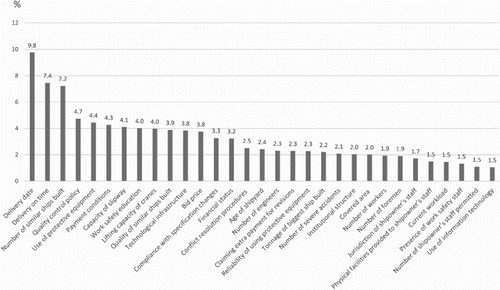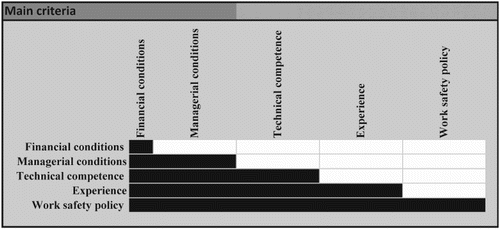Abstract
There are various stages to the process of acquiring a vessel. First, a decision must be made on what vessel is needed. Next, an appropriate shipyard is selected; this decision is very significant, as it will determine the workmanship quality and delivery date of the vessel to be manufactured. From the point of view of a shipowner, receiving the vessel on time and manufactured to specification is crucial. From the point of view of the shipyard, it is vital to take as many orders as possible; therefore, one of the highest priorities of shipyards is to be the first choice for as many shipowners as possible in order to increase their requirement for steel fabrication and consequently their profits. In this study, the shipyard selection criteria for shipowners are presented and the degree of importance of each criterion is determined using a fuzzy analytic hierarchy process (AHP) technique. The aim of the study is to provide shipyards with information about the perspective of shipowners with regard to the shipyard selection process, thus allowing shipyards to strengthen their weaknesses and increase the number of shipowners which choose them to manufacture their ships.
Introduction
Operations in the maritime industry involve a large number of interrelated partners, with each performing manufacturing or distribution activities, thus forming a ‘maritime supply chain’ (Chryssolouris et al. Citation2004). The shipowner and shipyard are the main components of this chain; both are involved with repair operations and new vessel building activities.
The new vessel building process is a critical issue for shipowners, as they want to obtain vessels constructed in accordance with precise specifications which are tailored to their requirements. Furthermore, it is important thing for shipowners to obtain their new vessels as quickly as possible; the sooner the vessel is constructed, the earlier the vessel is put into operation and the quicker it begins to earn money, bringing in a return on investment for both the shipowner and shipyard.
A modern ship is a very complex facility, combining various types of equipment, technologies, and disciplines; the capital invested in a new merchant ship is massive (Xie et al. Citation2008). Therefore, the selection of an appropriate shipyard which can fabricate the vessel in accordance with the specifications and requirements of the shipowner in a relatively quick turnaround time is crucial.
After the decision about the type of vessel required has been made, the next step is to prepare the documents, including vessel specifications and drawings, which precisely detail the vessel. These documents will be submitted to various shipyards, which will return proposals in terms of what they can provide and how soon the ship can be completed. At this point, it is absolutely crucial to select the most appropriate shipyard. When selecting a shipyard, the shipowner needs to consider various parameters. If the selected shipyard is not appropriate then the vessel fabrication may be affected in a negative way, such as late delivery or poor workmanship, resulting in a loss of some of the return on the massive investment in the ship.
In the literature, there are few works which examine shipyard selection criteria for new vessel construction. Celik, Kahraman et al. (Citation2009) studied the shipyard selection criteria for docking facilities of shipyards by using multiple-criteria fuzzy axiomatic design (FAD). For this study, 11 shipyards situated in Turkey were chosen as examples and by determining the weights of the criteria, the most suitable shipyards for docking facilities were presented in terms of which ones meet these criteria the best. Ozyigit (Citation2006) presented the shipyard selection criteria for shipbuilding and recommended that they could be employed in the process of shipyard selection.
The Canadian government wanted to commission the construct ion of a number of large vessels and five Canadian shipyards were short listed. These shipyards were evaluated according to some performance criteria such as the shipyard's current status and contracts, the cost to Canada for improvements, the shipyard's financial status, the offered price, etc. (Public Works and Government Services Canada Citation2014).
In this study, the criteria which need to be considered by shipowners were identified and the impact of these criteria on the process of selecting an appropriate shipyard were determined. For this, the methodology of the fuzzy analytic hierarchy process (AHP) implemented by Buckley (Citation1985) was employed. Fuzzy AHPs have been applied across a range of fields, including construction (Hsieh et al. Citation2004; Jaskowski et al. Citation2010), education (Goksu Citation2008; Celik, Kandakoglu, & Er Citation2009), human resources (Chou et al. Citation2012), location selection (Bilisik et al. Citation2014), marine engineering (Miri Lavasani et al. Citation2011; Wang & Chin Citation2011; Celik & Kandakoglu Citation2012; Yanar & Tozan Citation2012), the automotive industry (Nepal et al. Citation2010; Badizadeh & Khanmohammadi Citation2011; Bilgen & Sen Citation2012; Ghadimi et al. Citation2012; Rathi et al. Citation2015), supplier selection (Chan et al. Citation2008; Kilincci & Onal Citation2011; Yucenur et al. Citation2011; Shaw et al. Citation2012; Rezaei et al. Citation2014) and technology management (Erensal et al. Citation2006). A comprehensive description of the methodology is expounded in the next section. The aim of the study is to provide knowledge for shipyards about the point of view of shipowners when selecting a shipyard. In this way, shipyards may be able to strengthen their weaknesses and thus become the first choice of more shipowners.
Methodology
The thoughts of decision-makers and experts about an issue can be clearly described with fuzzy logic. A fuzzy AHP is presented for the purpose of resolving the lack of manifesting human perception and thought of the AHP developed by Thomas Saaty (Tayal et al. Citation2009). In the literature, many fuzzy AHP methods are proposed by different authors. In this study, Buckley's (Citation1985) fuzzy AHP method is implemented. The steps followed in the study are explained below.
Step 1: definition of the criteria
Decision-makers and/or experts establish the qualifying criteria for shipyard selection.
Step 2: definition of the linguistic terms
The linguistic scale and fuzzy numbers used in the study are appointed from the literature.
Step 3: the collection of expert opinions
Expert assessments on the degree of importance of each criteri on were amassed with the aid of a survey (see Appendix 1). Equation (1) shows the fuzzy decision matrix.
(1)
(2) where
is a fuzzy decision matrix given by the kth expert for the degree of importance of each criteri on,
, p is number of experts,
is the fuzzy comparison value of criterion i to criterion j according to the kth expert,
and n is the number of compared criteria. The abbreviations in Equation (2) are as follows: ‘demon’ is short for ‘demonstratively’, ‘eq’ is short for ‘equally’, ‘im’ is short for ‘important’, ‘Mod’ is short for ‘moderate’ and ‘str’ is short for ‘strongly’. An example of expanding these abbreviations is as follows: Row demon. im. is short for ‘the criterion in the row is demonstratively more important than the criterion in the column’ (for the full versions of all the statements, see Appendix 1).
Step 4: the transformation of the data into triangular fuzzy numbers
The linguistic evaluations must be converted into triangular fuzzy numbers (TFNs), as mathematical operations cannot be performed on verbal expressions. A fuzzy set is represented by a membership function, , which defines the membership degree of the elements in the range [0, 1] (Zadeh Citation1965). The description of a TFN is given in Equation (3):
(3) where
is a membership function,
is the lower boundary,
is the upper boundaryand
is the mean value. For an example of a TFN, see .
Let and
be two triangular fuzzy numbers; the algebraic operations are summarized below (Chen & Hwang Citation1992):
(4)
(5)
(6)
(7)
(8)
A positive fuzzy number, , is defined as
(Zimmermann Citation2001).
Step 5: aggregation of the experts’ preferences
In the case of there being more than one expert opinion collected during the assessment stage, an aggregation process is needed to combine the experts’ preferences. The geometric mean method is used to obtain an aggregated pairwise comparison matrix (Hsieh et al. Citation2004).
(9-10) where
is an aggregated pairwise comparison matrix for the degree of importance of each criterion ,
is the aggregated fuzzy comparison value of criterion i to criterion j, p is the number of experts,
and n is the number of compared criteria.
Step 6: calculation of the criteria weights
In presented study, Buckley's (Citation1985) fuzzy AHP is applied to calculate the fuzzy weights. The method is summarized below (Celik, Kandakoglu, & Er Citation2009):
After the aggregated pairwise comparison matrix, , is obtained, the fuzzy weight matrix is calculated by Buckley's (Citation1985) method as follows:
(10-11) where
is the geometric mean of the fuzzy comparison value of criterion i to each criterion,
is the fuzzy weight of the ith criterion,
and n is the number of compared criteria.
Step 7: the defuzzification and normalization procedure for the fuzzy weights
In order to convert the fuzzy weights into crisp values, the centroid method, which generates a crisp value based on the centre of the gravity, is applied:
(13) where
is the crisp weight of the ith main or sub-criterion,
is the lower boundary,
is the upper boundaryand
is the mean value of the fuzzy weight of the ith criterion.
The crisp values should be normalized to obtain much more comprehensible results as follows (Ding Citation2011):
(14) where
is the normalized crisp weight of the ith main criterion,
is the crisp weight of the ith main criterion calculated by Equation (13)and b is the number of main criteria.
For sub-criteria, the following equation is used:
(15) where
is the normalized crisp weight of the ith sub-criterion,
is the crisp weight of the ith sub-criterion calculated by Equation (13)and g is the number of sub-criteria under the germane main criterion.
Step 8: calculation of the relative criteria weights
In order to compare sub-criteria among themselves, relative crisp weights are calculated as follows:
(16) where
is the relative crisp weight of the ith sub-criterion,
is the normalized crisp weight of the main criterion which includes the germane sub-criterion,
is the normalized crisp weight of the ith sub-criterion,
and g is the number of sub-criteria under the germane main criterion. Due to the fact that number of sub-criteria under each main criterion is not equal, an equalization process is recommended in order to obtain a realistic comparison:
(17) where
is the equalized crisp weight of the ith sub-criterion, g is the number of sub-criteria under the germane main criteria and t is the total number of sub-criteria. After this, a normalization is applied:
(18) where
is the equalized and normalized crisp weight of the ith sub-criterion and t is the total number of all sub-criteria.
Application
In this study, the preferences of four experts who have experience with shipbuilding were collected.
Step 1: definition of the criteria
The model constructed in this study consists of five main criteria: financial conditions, managerial conditions, technical competence, experience and work safety policy. These main criteria also include a considerable number of sub-criteria ( and ).
Table 1. The definitions of the sub-criteria used in the shipyard selection process.
Step 2: definition of the linguistic terms
The linguistic terms used in the study and their equivalent fuzzy numbers are given in (Erensal et al. Citation2006).
Table 2. Linguistic terms used to evaluate the criteria and sub-criteria.
Step 3: the collection of expert preferences
The expert preferences on the degree of importance of each criterion were collected using a questionnaire. To illustrate the collected data, the preferences of Expert 1 for the degree of importance of each main criterion are presented in .
Table 3. Pairwise comparison for the main criteria.
Step 4: the transformation of the data into TFNs
In this paper, the linguistic scale given in was used for pairwise comparisons. The linguistic terms were converted into TFNs by using this scale. For instance, column very str. im. in was converted to (1/9,1/7,1/5). In the same way, row very str. im. was converted to (5,7,9).
Step 5: aggregation of the experts’ preferences
There are four experts in the evaluation procedure and it is accepted that each specialist has the same authorization for the final decision. The aggregated fuzzy decision matrices were calculated by Equations (9) and (10) and are given in Tables –. As an example, aggregation for pairwise comparisons of the financial conditions and managerial conditions criteria is calculated below:
Table 4. Aggregated pairwise comparisons for the main criteria.
Table 5. Aggregated pairwise comparisons for the financial conditions sub-criteria.
Table 6. Aggregated pairwise comparisons for the managerial conditions sub-criteria.
Table 7. Aggregated pairwise comparisons for the technical competence sub-criteria.
Table 8. Aggregated pairwise comparisons for the experience sub-criteria.
Table 9. Aggregated pairwise comparisons for the work safety policy sub-criteria.
Step 6: calculation of the criteria weights
The fuzzy weights of the criteria calculated by Buckley's (Citation1985) Fuzzy AHP according to Equations (11) and (12) are given in . As an example, the fuzzy weight of the financial conditions criterion was calculated as follows:
The subscripts are defined as follows: 1= financial conditions, 2= managerial conditions, 3= technical competence, 4 = experience and 5= work safety policy.
Step 7: the defuzzification and normalization procedure for the fuzzy weights
Firstly, the fuzzy weights were def uzzified to obtain crisp weights using Equation (13). After this, normalized crisp criteria weights were calculated according to Equations (14) and (15). The normalized crisp weights are given in . As an example, the defuzzification and normalization of the main criteria are as follows (with the subscripts defined as in the previous step:
Table 10. The degrees of importance of all main and sub-criteria.
Step 8: calculation of the relative criteria weights
The relative crisp weights were calculated using Equation (16), and the equalized and normalized crisp weights were calculated using Equations (17) and (18) (). As an example, the equalized and normalized crisp weight of the sub-criterion bid price is calculated below:
In the above calculations, g = 3 because bid price comes under the main criterion financial conditions and there are a total of 3 sub-criteria under this criterion, and t = 31 because there are 31 sub-criteria in total across all main criteria.
Discussion
According to the calculated weights using Buckley's (Citation1985) fuzzy AHP, criteria are compared in this chapter. shows the weights of the main criteria which play a role in shipyard selection. Technical competence and experience have a weight of 25% among all the criteria, so they are most considered by shipowners when selecting the shipyard, followed by financial conditions.
displays the sub-criteria of financial conditions. As can be seen, payment conditions is the most significant sub-criteria since it has a weight of 41% in financial conditions.
depicts the sub-criteria of managerial conditions and it can be seen that financial status and conflict resolution procedures have more weights than the others. Therefore, in terms of managerial conditions, these two sub-criteria have more influence on shipowners in the decision-making process.
shows the sub-criteria of technical competence. In this criterion, it is the delivery date and delivery on time which are most important to the shipowner.
displays the sub-criteria of experience. Accordingly, the sub-criterion of number of similar ships built has a weight of 61%. Therefore, the most important factor is the shipyard's experience in constructing vessels similar to the one that the shipowner requires.
, which examines the sub-criteria of work safety policy, shows that the sub-criteria of use of protective equipment and work safety education are considered by the shipowner in the shipyard selection process.
depicts the weights of each sub-criterion among all sub-criteria. For instance, delivery date has a weight of around 10% across all sub-criteria, while delivery on time and number of similar ships built follow with a weight of around 7%. In this way, the weights of all the sub-criteria and their degrees of importance in the shipyard selection process can be seen in.
Conclusion
Taking into consideration the main criteria, technical competence and experience are the most significant for shipowners by a weight of around 25%. Examining the sub-criteria, the most important factors for the shipowner are delivery date, delivery on time, number of similar ships built, quality control policy and use of protective equipment, which have percentages of 9.8%, 7.4%, 7.2%, 4.7% and 4.4%, respectively.
Shipyard management can now consider the viewpoints of shipowners and the most crucial factors to their decision-making process when determining which shipyard to select, and then modify their performance and presentation accordingly. By strengthening any of the most important areas which may currently be weak, they are likely to increase the number of orders they receive from shipowners.
Disclosure statement
No potential conflict of interest was reported by the authors.
References
- Badizadeh A, Khanmohammadi S. 2011. Developing a fuzzy model for assessment and selection of the best idea of new product development. Indian J Sci Technol. 4:1749–1762.
- Bilgen B, Sen M. 2012. Project selection through fuzzy analytic hierarchy process and a case study on Six Sigma implementation in an automotive industry. Prod Plan Control. 23:2–25.
- Bilisik ON, Demirtas N, Tuzkaya UR, Baracli H. 2014. Garage location selection for public transportation system in Istanbul: an integrated fuzzy AHP and fuzzy axiomatic design based approach. J Appl Math. 2014:1–13.
- Buckley JJ. 1985. Fuzzy hierarchical analysis. Fuzzy Set Syst. 17:233–247.
- Celik M, Kahraman C, Cebi S, Er ID. 2009. Fuzzy axiomatic design-based performance evaluation model for docking facilities in shipbuilding industry: the case of Turkish shipyards. Expert Syst Appl. 36:599–615.
- Celik M, Kandakoglu A. 2012. Maritime policy development against ship flagging out dilemma using a fuzzy quantified SWOT analysis. Marit Policy Manag. 39:401–421.
- Celik M, Kandakoglu A, Er ID. 2009. Structuring fuzzy integrated multi-stages evaluation model on academic personnel recruitment in MET institutions. Expert Syst Appl. 36:6918–6927.
- Chan FT, Kumar N, Tiwari M, Lau H, Choy K. 2008. Global supplier selection: a fuzzy-AHP approach. Int J Prod Res. 46:3825–3857.
- Chen S-J, Hwang C-L. 1992. Fuzzy multiple attribute decision making (methods and applications). London: Springer-Verlag Berlin Heidelberg.
- Chou Y-C, Sun C-C, Yen H-Y. 2012. Evaluating the criteria for human resource for science and technology (HRST) based on an integrated fuzzy AHP and fuzzy DEMATEL approach. Appl Soft Comput. 12:64–71.
- Chryssolouris G, Makris S, Xanthakis V, Mourtzis D. 2004. Towards the Internet-based supply chain management for the ship repair industry. Int J Comput Integ M. 17:45–57.
- Ding J-F. 2011. An Integrated fuzzy TOPSIS method for ranking alternatives and its application. J Mar Sci Technol. 19:341–352.
- Erensal YC, Oncan T, Demircan ML. 2006. Determining key capabilities in technology management using fuzzy analytic hierarchy process: A case study of Turkey. Inf Sci (Ny). 176:2755–2770.
- Ghadimi P, Azadnia AH, Mohd Yusof N, Mat Saman MZ. 2012. A weighted fuzzy approach for product sustainability assessment: a case study in automotive industry. J Clean Prod. 33:10–21.
- Goksu A. 2008. Fuzzy analytic hierarchy process and its application of university preference ranking [PhD]. Isparta: University of Suleyman Demirel.
- Hsieh T-Y, Lu S-T, Tzeng G-H. 2004. Fuzzy MCDM approach for planning and design tenders selection in public office buildings. Int J Proj Manag. 22:573–584.
- Jaskowski P, Biruk S, Bucon R. 2010. Assessing contractor selection criteria weights with fuzzy AHP method application in group decision environment. Automat Constr. 19:120–126.
- Kilincci O, Onal SA. 2011. Fuzzy AHP approach for supplier selection in a washing machine company. Expert Syst Appl. 38:9656–9664.
- Miri Lavasani S, Yang Z, Finlay J, Wang J. 2011. Fuzzy risk assessment of oil and gas offshore wells. Process Saf Environ. 89:277–294.
- Nepal B, Yadav OP, Murat A. 2010. A fuzzy-AHP approach to prioritization of CS attributes in target planning for automotive product development. Expert Syst Appl. 37:6775–6786.
- Ozyigit I. 2006. Planning and production stages in shipbuilding [MSc]. İstanbul: Yildiz Technical University.
- Public Works and Government Services Canada. 2014. Backgrounder: Achieving Best Value in Shipyard Selection: Available from: http://www.tpsgc-pwgsc.gc.ca/app-acq/sam-mps/ddi-bkgr-6-eng.html
- Rathi R, Khanduja D, Sharma S. 2015. Synergy of fuzzy AHP and Six Sigma for capacity waste management in Indian automotive industry. Decision Sci Lett. 4:441–452.
- Rezaei J, Fahim PB, Tavasszy L. 2014. Supplier selection in the airline retail industry using a funnel methodology: Conjunctive screening method and fuzzy AHP. Expert Syst Appl. 41:8165–8179.
- Shaw K, Shankar R, Yadav SS, Thakur LS. 2012. Supplier selection using fuzzy AHP and fuzzy multi-objective linear programming for developing low carbon supply chain. Expert Syst Appl. 39:8182–8192.
- Tayal DK, Jain A, Aggarwal N, Bhasin P. 2009. A fuzzy analytical hierarchical process-based career decision making. IUP J Inf Technol. 5:36–51.
- Wang Y-M, Chin K-S. 2011. Fuzzy analytic hierarchy process: A logarithmic fuzzy preference programming methodology. Int J Approx Reason. 52:541–553.
- Xie X, Xu D-L, Yang J-B, Wang J, Ren J, Yu S. 2008. Ship selection using a multiple-criteria synthesis approach. J Mar Sci Technol. 13:50–62.
- Yanar L, Tozan H. 2012. A fuzzy hybrid decision support system for interceptor Baywatch boat propulsion system selection. Teh Vjesn. 19:407–413.
- Yucenur GN, Vayvay O, Demirel NC. 2011. Supplier selection problem in global supply chains by AHP and ANP approaches under fuzzy environment. Int J Adv Manuf Technol. 56:823–833.
- Zadeh LA. 1965. Fuzzy sets. Inf Control. 8:338–353.
- Zimmermann H-J. 2001. Fuzzy set theory—and its applications. 4th ed. New York (NY): Springer Netherland.
Appendix 1
The survey was prepared in Microsoft Excel. Experts evaluated the degree of importance of each criterion by making pairwise comparisons. depicts a portion of the survey. White coloured cells were filled based on the following procedure.
The decision-maker chooses the degree of importance of the selection criterion by comparing it with the other criteria for shipyard selection. If the criterion in the row is judged as being more important than the criterion the in column then one of the options below is selected in order to determine ‘how important the criterion is':
Row demon. im. (the criterion in the row is demonstratively more important than the criterion in the column);
Row very str. im. (the criterion in the row is very strongly more important than the criterion in the column);
Row str. im. (the criterion in the row is strongly more important than the criterion in the column);
Row mod. im. (the criterion in the row is moderately more important than the criterion in the column).
If the criterion in the column is judged as being more important than the criterion in the row then one of the options below is selected in order to determine ‘how important the criterion is':
Column mod. im. (the criterion in the column is moderately more important than the criterion in the row);
Column str. im. (the criterion in the column is strongly more important than the criterion in the row);
Column very str. im. (the criterion in the column is very strongly more important than the criterion in the row);
Column demon. im. (the criterion in the column is demonstratively more important than the criterion in therow).
If the criterion in the row is judged as being equally important as the criterion in the column then the option below is selected in order to determine ‘how important the criterion is':
Row-column eq. (the criterion in the row is equally important to the criterion in the column).

